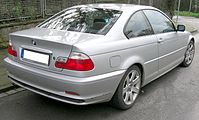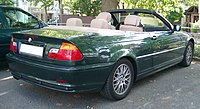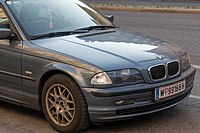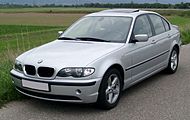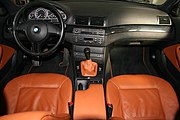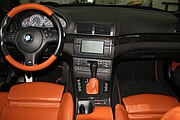BMW E46
| BMW | |
|---|---|
|
BMW 3 Series Sedan (1998-2001)
|
|
| E46 | |
| Sales designation: | 3 series |
| Production period: | 1998-2007 |
| Class : | Middle class , compact class |
| Body versions : | Sedan , hatchback , station wagon , coupe , convertible |
| Engines: |
Gasoline engines : 1.6-4.0 liters (77-265 kW) Diesel engines : 2.0-3.0 liters (85-150 kW) |
| Length: | 4262-4527 mm |
| Width: | 1739-1780 mm |
| Height: | 1369-1434 mm |
| Wheelbase : | 2725-2730 mm |
| Empty weight : | 1360-1790 kg |
| Previous model | BMW E36 |
| successor |
BMW E90 (for Compact E46 / 5: BMW E81 ) |
| Stars in the Euro NCAP - Crash Test (2001) |
|
The E46 series is the fourth 3 series from the car manufacturer BMW . The middle class series was presented in March 1998 as the successor to the E36 series.
The E46 models were produced in the Munich-Milbertshofen parent plant and the Leipzig , Regensburg and Rosslyn (South Africa) plants. Other manufacturers were BMW Brilliance Automotive in Shenyang (China), the Bavarian Auto Group in the city of October 6 (Egypt) and Avtotor in Kaliningrad (Russia).
Model history
General
The fourth generation of the BMW 3 Series, the BMW E46, appeared at the end of April 1998. As usual at BMW, initially only as a sedan, with revised six-cylinder ( M52TU ) and four-cylinder ( M43TU ) petrol engines and a newly developed four-cylinder diesel engine ( M47 ). With the M47, BMW sold a diesel engine with direct injection for the first time . The safety equipment in all models included the anti-lock braking system (ABS), traction control ( ASC + T ), cornering brake control , electronic brake force distribution and six airbags as standard . Electronic vehicle dynamics control was initially only available for an extra charge of DM 1,800 for the 328i, later as an option for all models, and finally as standard. From model year 2001 a brake assistant was also standard .
Aluminum was used in the chassis: 60 kg, which corresponds to a share of 20%. The high-strength steel on the front and rear axle supports resulted in further weight savings.
The E46 was equipped with a 5-speed manual gearbox as standard from its appearance. The diesel models from 320d, 330i and 325ti with 6-speed manual gearbox were only delivered from model year 2003. On request, there was a 4-stage automatic for the four-cylinder models and a 5-stage Steptronic (automatic) for the six-cylinder models. For the 325i / Ci / ti (Limousine / Touring / Coupé / Cabrio / Compact) and 330i / Ci (Limousine / Touring / Coupé / Cabrio) there was also an optional sequential manual transmission with the short name SMG, which was a special feature from BMW is. The SMG is an automated manual transmission that can be shifted manually using the selector lever and shift paddles as well as automatically. It was delivered with 5 gears until 2003, then with 6 gears.
In April 1999, the coupé and shortly afterwards the six-cylinder M57 diesel engine , which was initially only available in the sedan and in the station wagon that appeared in October 1999 and is traditionally called Touring at BMW . Only with the "facelift" (model upgrade) of the coupé and convertible in 2003 was this diesel engine available for these models.
The convertible followed in April 2000. In June 2000, the 330i was the first M54 engine, and in the autumn the other M52TU six-cylinder units were also replaced by more powerful M54 versions. Along with the M54 engines, there were also the models with all-wheel drive with the additional designation xi (Otto engine) or xd (Diesel engine).
In June 2001 the Compact was launched based on the E46 series. For the first time, engines with the new Valvetronic were used, which also appeared in the other E46 variants in the new model year that began a few months later. Externally, the Compact differs from the other designs at the rear and at the front.
The BMW E46 was one of the best-selling vehicles in its day. With it, the modern direct-injection diesel engines were also introduced at BMW , which at that time set standards in performance and smoothness. Compared to its predecessor (E36), the passenger cell has been designed to be much more stable, thus increasing accident safety.
Production periods
- Sedan (E46 / 4): March 1998 to February 2005
- Coupé (E46 / 2): April 1999 to June 2006
- Touring (E46 / 3): October 1999 to June 2005
- Convertible (E46 / 2C): March 2000 to February 2007
- Compact (E46 / 5): June 2001 to December 2004
- M3 Coupé (E46 / 2S): June 2000 to May 2006
- M3 Cabrio (E46 / 2CS): April 2001 to June 2006
Facelift
In September 2001 the sedan and the Touring received a facelift , which made them more similar to the 5 Series modified a year earlier , but did not have parking light rings. In addition, a new four-cylinder engine generation with the variable valve control Valvetronic appeared. The exterior of the lifted version is recognizable primarily by the differently shaped front and rear lights, the flatter, wider and more angular BMW kidneys , the now outward beading on the bonnet, as well as the side indicators of the front lights, their outgoing contours from the Belt line was moved high on the shoulder line of the vehicle.
Another important revision, which was not externally visible at first glance, concerned the attachment of the rear axle to the body. Here, cracks formed frequently - especially in vehicles with six-cylinder engines from the first years of production - which required very complex and expensive repairs (complete dismantling of the rear and replacement of a large body part). As a preventive measure and alternative to complete repairs when cracks were not yet very advanced, BMW offered for a time the targeted gluing of the sheet metal at risk of cracking with a special resin.
An ESP (Electronic Stability Program) was standard in all models from September 2001.
In March 2003 the Coupé and Cabriolet were revised, but they could still be easily distinguished from the sedan. There was no facelift for the M3 and M3 CSL models during the entire construction period. Only the rear lights were replaced with slightly modified lights with LED technology.
As part of the revision measures for the 3 Series, the following engine variants were also switched to manual 6-speed gearshifts from March 2003 instead of just 5-speed gearboxes: 320d, 330d, 330i. This affected all body variants with such a motor, i.e. coupé, convertible, touring and sedan, and also the 325ti Compact. The gear ratio and the performance remained the same, since 6th gear is an overdrive gear that reduces speed, consumption, wear and tear and noise.
The prices from 2004 ranged from 21,500 euros for a 3 Series Compact to 85,000 euros for the M3 CSL.
The Compact also received a refresh in March 2003. It should defuse the unusual clear glass taillights with completely red taillights. In addition, there were outwardly curved side skirts and an additional bead in the trunk lid.
Nevertheless, the Compact of the E46 series could not repeat the success of its predecessor and became a flop. Its production was stopped in December 2004 after just over three years of construction. BMW later learned from the mistakes in its market positioning and developed as its successor the BMW 1 Series , an independent series that is supposed to compete with the Audi A3 and VW Golf in the compact class.
The successor to the sedan ( E90 ) was introduced in March 2005 . The Touring (E91) followed in September 2005. The Coupé (E92) came on the market in September 2006 and the Cabrio (E93) in March 2007.
In addition to the versions mentioned, there was the performance-enhanced M3 sports car at BMW M GmbH in Munich . In the E46 Coupé and Cabriolet, the M3 draws 252 kW (343 hp) from a six-cylinder in-line engine with individual throttle valve injection. In the weight-reduced, limited version M3 CSL , 265 kW (360 PS) are available.
The BMW tuner Alpina , on the other hand, focused on a more comfort-oriented sportiness with its E46 versions Alpina B3 and B3S (3.3 l / 3.4 l displacement, 206 kW / 224 kW). The engine is based on that of the E36 US-M3 version (S50USB30 and S52USB32 = cast iron engine block, aluminum cylinder head with two overhead camshafts and VANOS, a throttle valve) which has been modified with an Alpina crank drive and other pistons, among other things. These models were also available as a sedan, touring, convertible and all-wheel drive and are not limited to 250 km / h, but reach a top speed of around 270 km / h.
Interior variants
Weak points
Like every vehicle, the BMW E46 also has certain weaknesses in its design, with most of the problems gradually improved and fixed by BMW over the years. These vulnerabilities include:
- The differential is leaking in some used vehicles and tends to howl when overrun.
- Although the diesel engines of the E46 are generally very stable, they sometimes have problems in the area of the turbocharger and the common rail injection pumps (330d).
- The 320d attracts attention with frequently defective air mass meters.
- The chassis shows high wear on strut bearings, ball joints, wishbone bearings and the rear axle suspension on bad roads. There are more stable components in the spare parts trade.
- The electronics occasionally “spin” around the immobilizer, and navigation systems and telephones often cause malfunctions.
- Especially when touring, drops of condensation water can form above the navigation computer in the trunk, which can damage the computer's electronics.
- Depending on the driving style, the brake system sometimes shows high wear.
As already mentioned above in the “Model Care” section, cracks formed in the attachment of the rear axle to the body, which required very complex and expensive repairs. As a preventive measure and also as an alternative to complete repairs when cracks were not yet very advanced, BMW offered for a time the targeted gluing of the sheet metal at risk of cracking with a special resin. This problem occurred mainly in vehicles with six-cylinder engines from the first years of production and was rectified by BMW in the facelift in September 2001.
According to Auto Bild, many customers also complain about the steering wheel shaking when braking and on uneven roads. However, the fault is allegedly neither a defective steering nor the braking system, but the soft mounting of the front wishbones and the too direct translation of the steering.
During the main inspections of four to five year old vehicles of the E46, the engineers at the Dekra test center determine frequent failures of the parking brake. The reason for this is that the cables stretch and then weaken. Problems with the wheel suspension are also criticized above average. In summary, Dekra wrote the following about the BMW E46:
“Buying a used 3-series BMW is not cheap. But the used car buyer can enjoy typical BMW advantages: the equipment is rich, the quality of the extras such as leather upholstery, audio system and tightness of the sliding glass roof remains free of complaints even after years and the electronics are always reliable. Neither the breakdown services nor the critical looks of the Dekra test engineers noticed it as being prone to failure. "
According to the Auto Zeitung, the front axle of the four-cylinder models often shook slightly when braking. However, BMW was able to solve this problem by making a design change to the control arms and ball heads.
Safety-related problems were noticed on the brake pedal of the BMW E46. For example, the pedal mechanism failed in a test car from Auto Zeitung in 1999. A bolt slipped out of its guide due to the lack of a spring clamp, causing the brake pedal to unhook. Since this was not an isolated case, BMW responded with a recall campaign and improved all affected vehicles.
The braking effect itself is considered good in the 3 Series. However, used car buyers are often recommended to brake tests in order to identify warped brake disks based on scratching noises from the brake system. These panes, which have mostly become unusable due to overheating, must then be replaced.
All of the E46's engines have proven to be robust and durable. The 320d, which were delivered in the first two years of production, had some problems with the powerful starting torque. The high torque overwhelmed the clutch, made it pluck when the clutch was engaged and therefore quickly wore out.
In the case of gasoline engines, the ADAC registers more frequent failures due to defective coolers, which are usually damaged by falling rocks and can leak. If the coolant level is too low, it can also lead to failures due to burned-out cylinder head gaskets. Possible starting problems due to damp spark plugs have been corrected from model year 1999 by installing a new generation of spark plugs.
An expert from TÜV SÜD summarizes the weak points of the BMW E46 as follows:
“The weaknesses of the chassis also lead to a below-average performance of the E46 in our statistics. It's a shame, because the 3 Series is top in most other areas. The only exception to this is the handbrake, which occasionally has no effect, but above all often pulls unevenly. On the other hand, great praise for the headlights, which give grounds for complaint much less often than with the predecessor. "
Furthermore, there are two weaknesses in the E46 models, especially in diesel engines. The first weak point are the swirl flaps in the intake manifold; these can loosen and then fall into the combustion chamber, where they completely destroy the engine; in some cases this already happens from 80,000 km onwards. After the warranty expires at 100,000 km, the vehicle owner faces repair costs of between € 3,500 and € 4,000. To avoid engine damage, more and more owners are switching to decommissioning or removing the swirl flaps. The resulting openings are closed with so-called swirl flap plugs. These are mainly made of aluminum or GRP.
The other weak point is the automatic transmission in diesel. The 330d has a torque of 410 Nm, but the automatic transmission can only withstand a maximum of 390 Nm. The consequence of this is often transmission damage between 100,000 km and 150,000 km. Here too, the BMW guarantee no longer applies.
In recent years there have been increasing reports of problems with the central locking in various BMW forums, especially in older models. The cause were mostly worn relays on the circuit board of the basic module of the central locking system. However, these can also be replaced individually, so that in most cases it is not necessary to replace the basic module. In the meantime, some small companies have specialized in replacing relays and offer them as an external service.
Engines
Petrol engines
Four-cylinder gasoline engines
| model | 316i | 318i / Ci | 316i / Ci / ti (1) | 316i / ti | 318i / Ci / ti | 318Ci | ||
|---|---|---|---|---|---|---|---|---|
| Construction period | 03/1998 - 08/2001 | 06/2001 - 02/2004 | 09/2003 - 05/2006 | 08/2001 - 06/2005 | 08/2001 - 02/2007 | 03/2005 - 02/2007 | ||
| Engine type | R4 | |||||||
| Engine type | M43TÜ B19 UL | M43TÜ B19 OL | N40 B16 | N45 B16O1 | N42 / N46 B18 | N42 / N46 B20 | N46 B20 | |
| Displacement | 1895 cc | 1596 cc | 1796 cc | 1995 cc | 1995 cc | |||
| variable valve control | - | Valvetronic | ||||||
| Max. Power at 1 / min |
77 kW (105 PS) / 5300 |
87 kW (118 PS) / 5500 |
85 kW (116 PS) / 6100 |
85 kW (116 PS) / 6000 |
85 kW (116 PS) / 5500 |
105 kW (143 PS) / 6000 |
110 kW (150 PS) / 6200 |
|
| Max. Torque at 1 / min |
165 Nm / 2500 |
180 Nm / 3900 |
150 Nm / 4300 |
150 Nm / 4300 |
175 Nm / 3750 |
200 Nm / 3750 |
200 Nm / 3600 |
|
| Gearbox, as standard | 5-speed manual transmission | |||||||
| Gearbox, optional | 4-speed automatic transmission | 5-speed automatic transmission | ||||||
| Drive, as standard | Rear wheel drive | |||||||
| Acceleration, 0–100 km / h in s |
limousine | 12.4 [13.6] | 10.4 | - | 10.9 [11.9] | 9.3 [10.2] | - | |
| Touring | - | 10.9 [12.6] | - | 11.2 [12.2] | 9.6 [10.5] | - | ||
| Compact | - | - | 10.9 [11.9] | 9.3 [10.2] | - | |||
| coupe | - | 10.4 [12.2] | - | - | 9.3 [10.2] | 9.2 [10.1] | ||
| Convertible | - | 10.4 [11.2] | 10.3 [11.2] | |||||
| Top speed in km / h |
limousine | 200 [194] | 206 | - | 206 [200] | 218 [214] | - | |
| Touring | - | 202 [196] | - | 200 [194] | 213 [209] | - | ||
| Compact | - | - | 201 [196] | 214 [211] | - | |||
| coupe | - | 206 [202] | - | 218 [214] | 219 [215] | |||
| Convertible | - | 206 [206] | 207 [207] | |||||
| Fuel consumption in l / 100 km |
limousine | 7.8 [8.9] | 7.9 | - | 7.1 [8.0] | 7.2 [8.1] | - | |
| Touring | - | 8.1 [9.3] | - | 7.3 [8.1] | 7.4 [8.2] | - | ||
| Compact | - | - | 7.0 [7.8] | 7.4 [8.0] | - | |||
| coupe | - | 7.9 [9.1] | - | 7.2 [8.1] | 7.4 [8.1] | |||
| Convertible | - | 7.7 [8.4] | 7.8 [8.4] | |||||
| Tank capacity | 63 l | |||||||
Values without brackets apply to manual transmissions, values in brackets () apply to all-wheel drive, values in square brackets [] apply to automatic transmissions.
- ↑ i stands for petrol engine, C for coupé or convertible, t for compact, x for all-wheel drive.
- ↑ The start and end of the construction period is also determined by the design.
- ↑ a b from 2003 N46
Six-cylinder gasoline engines
| model | 320i / Ci | 323i / Ci | 325i / Ci / ti / xi | 328i / Ci | 330i / Ci / xi | ||
|---|---|---|---|---|---|---|---|
| Construction period | 03/1998 - 09/2000 | 09/2000 - 02/2007 | 03/1998 - 09/2000 | 09/2000 - 02/2007 | 03/1998 - 06/2000 | 09/1999 - 08/2006 | |
| Engine type | R6 | ||||||
| Engine type | M52TÜ B20 | M54 B22 | M52TÜ B25 | M54 B25 | M52TÜ B28 | M54 B30 | |
| Displacement | 1991 cc | 2171 cc | 2494 cc | 2793 cc | 2979 cc | ||
| Max. Power at 1 / min |
110 kW (150 PS) / 5900 |
125 kW (170 PS) / 6100 |
125 kW (170 PS) / 5500 |
141 kW (192 PS) / 6000 |
142 kW (193 hp) / 5500 |
171 kW (231 PS) / 5900 |
|
| Max. Torque at 1 / min |
190 Nm / 3500 |
210 Nm / 3500 |
245 Nm / 3500 |
245 Nm / 3500 |
280 Nm / 3500 |
300 Nm / 3500 |
|
| Gearbox, as standard | 5-speed manual transmission | ||||||
| Gearbox, optional | 5-speed automatic transmission | ||||||
| Drive, as standard | Rear wheel drive | ||||||
| Drive, optional | - | all wheel drive | - | all wheel drive | |||
| Acceleration, 0–100 km / h in s |
limousine | 9.9 | 8.3 [9.3] | 8.0 [9.0] | 7.2 [8.3] (7.5 [8.6]) |
7.0 [7.5] | 6.5 [7.0] (6.6 [7.4]) |
| Touring | 10.2 [11.4] | 8.5 [9.6] | - | 7.5 [8.6] (7.7 [8.8]) |
7.3 [8.4] | 6.7 [7.2] (6.8 [7.6]) |
|
| Compact | - | 7.1 [8.3] | - | ||||
| coupe | 9.9 [10.9] | 8.2 [9.3] | 8.0 [9.0] | 7.2 [8.3] | 7.0 [8.1] | 6.5 [7.0] | |
| Convertible | - | 8.8 [10.2] | 8.6 | 8.0 [9.1] | - | 6.9 [7.5] | |
| Top speed in km / h |
limousine | 219 | 226 [223] | 231 [228] | 240 [237] (234 [231]) |
240 | 250 [247] (247 [242]) |
| Touring | 214 [211] | 224 [221] | - | 237 [234] (231 [228]) |
237 [232] | 250 [243] (243 [238]) |
|
| Compact | - | 235 [232] | - | ||||
| coupe | 221 [218] | 226 [223] | 233 [230] | 240 [237] | 242 [237] | 250 [247] | |
| Convertible | - | 222 [219] | 225 | 234 [230] | - | 247 [240] | |
| Fuel consumption in l / 100 km |
limousine | 8.9 | 8.9 [9.4] | 9.0 [9.0-10.0] | 9.0 [9.5] (9.9 [10.6]) |
9.1 | 9.1 [9.6] (9.9 [10.6]) |
| Touring | 9.0 [10.2] | 9.0 [9.6] | - | 9.2 [9.7] (10.1 [10.9]) |
9.3 [10.3] | 9.3 [9.8] (10.1 [10.9]) |
|
| Compact | - | 8.9 [9.5] | - | ||||
| coupe | 8.9 [10.0] | 8.9 [9.4] | 9.0 [10.0] | 9.0 [9.5] | 9.1 [10.1] | 9.1 [9.6] | |
| Convertible | - | 9.4 [9.8] | 9.7 | 9.6 [9.9] | - | 9.6 [10.2] | |
| Tank capacity | 63 l | ||||||
Values without brackets apply to manual transmissions, values in brackets () apply to all-wheel drive, values in square brackets [] apply to automatic transmissions
- ↑ i stands for petrol engine, C for coupé or convertible, t for compact, x for all-wheel drive.
- ↑ The start and end of the construction period is also determined by the design.
- ↑ 330i: from 03/2003 6-speed
- ↑ a b c d electronically limited
M3 and Alpina
| M3 | M3 CSL | M3 GTR | Alpina B3 3.3 | Alpina B3 3.3 all-wheel drive | Alpina B3 S. | ||
|---|---|---|---|---|---|---|---|
| Construction period | 06 / 2000-02 / 2007 | 06 / 2003-09 / 2004 | 2001 | 03 / 1999-07 / 2002 | 07 / 2002–05 / 2005 | ||
| Engine type | R6 | V8 | R6 | ||||
| Engine type | S54 B32 | S54 B32HP | P60 B40 | E4 / 4 (E4 / 6) | E4 / 8 | E5 / 1 | |
| Displacement | 3246 cc | 3997 cc | 3300 cc | 3346 cc | |||
| Max. Power at 1 / min |
252 kW (343 hp) / 7900 |
265 kW (360 PS) / 7900 |
257 kW (350 PS) / 7250 |
206 kW (280 PS) / 6200 |
224 kW (305 PS) / 6300 |
||
| Max. Torque at 1 / min |
365 Nm / 4900 |
370 Nm / 4900 |
365 Nm / 5000 |
335 Nm / 4500 |
362 Nm / 4800 |
||
| Gearbox, as standard | 6-speed manual transmission | 6-speed automated manual transmission (SMG) | 6-speed manual transmission | 5-speed automatic transmission | 6-speed manual transmission | ||
| Gearbox, optional | 6-speed automated manual transmission (SMG) | - | 5-speed automatic transmission | - | 5-speed automatic transmission | ||
| Acceleration, 0–100 km / h in s |
limousine | - | 5.7 [6.6] | 6.9 | 5.4 [6.3] | ||
| Touring | - | 6.1 [6.9] | 7.2 | 5.8 [6.6] | |||
| coupe | 5.2 | 4.9 | <5.0 | 5.7 [6.6] | - | 5.4 [6.3] | |
| Convertible | 5.5 | - | 6.1 [6.9] | - | 5.8 [6.6] | ||
| Top speed in km / h |
limousine | - | 266 [261] | 256 | 270 [265] | ||
| Touring | - | 262 [257] | 252 | 266 [261] | |||
| coupe | 250 | 250 | 250 | 267 [262] | - | 271 [266] | |
| Convertible | 250 | - | 260 [255] | - | 264 [259] | ||
| Fuel consumption in l / 100 km |
limousine | - | 10.8 [11.7] | 11.6 | 10.9 [11.6] | ||
| Touring | - | 11.0 [11.9] | 11.7 | 11.1 [11.8] | |||
| coupe | 11.9 | 11.9 | - | 10.8 [11.7] | - | 10.9 [11.6] | |
| Convertible | 12.1 | - | 11.4 [11.9] | - | 11.2 [11.8] | ||
Values without brackets apply to manual transmissions, values in brackets () apply to all-wheel drive, values in square brackets [] apply to automatic transmissions
- ↑ Approx. 10 units were sold as homologation for the American Le Mans Series to selected customers in a street version with an engine that was reduced in power from> 330 to 257 kW due to the noise level
- ↑ a b c d electronically limited
Diesel engines
| model | 318d / td | 320d | 320d / cd / td | 330d / xd | 330d / cd / xd | |
|---|---|---|---|---|---|---|
| Construction period | 08 / 2001-02 / 2003 | 03/2003–06/2005 | 03 / 1998-08 / 2001 | 08 / 2001-08 / 2006 | 10/1999–02/2003 | 03 / 2003-08 / 2006 |
| Engine type | R4 | R6 | ||||
| Engine type | M47 D20 | M47 D20TÜ | M47 D20 | M47 D20TÜ | M57 D30 | M57 D30TÜ |
| Displacement | 1951 cc | 1995 cc | 1951 cc | 1995 cc | 2926 cc | 2993 cc |
| Max. Power at 1 / min |
85 kW (116 PS) / 4000 |
100 kW (136 PS) / 4000 |
110 kW (150 PS) / 4000 |
135 kW (184 PS) / 4000 |
150 kW (204 PS) / 4000 |
|
| Max. Torque at 1 / min |
265 Nm / 1750-2500 |
280 Nm / 1750 |
280 Nm / 1750 |
330 Nm / 2000-2500 |
390 Nm / 1750-3250 |
410 Nm / 1500-3250 |
| Drive, as standard | Rear wheel drive | |||||
| Drive, optional | - | all wheel drive | ||||
| Acceleration, 0–100 km / h in s |
10.7 | 10.6 | 9.9 | 8.8 | 7.8 | 7.2 |
| Top speed in km / h |
202 | 204 | 207 | 221 | 227 | 242 |
| Fuel consumption in l / 100 km |
- | 5.6 (6.8) | - | 5.5 (6.9) | - | 6.6 (7.7) |
| Tank capacity | 63 l | |||||
- ↑ d for diesel engine, Cd for coupé or convertible, td for compact, x for all-wheel drive.
- ↑ The start and end of the construction period is also determined by the design. Diesel engines in Coupé only from 2003, Cabriolet from 2004; 330xd from 2000, 318td from 2003.
- ↑ Limousine / Coupé / Compact with manual transmission; Touring or all-wheel drive approx. +0.2 s, Cabriolet approx. +0.4 to 1 s, automatic approx. +0.2 to 1 s.
- ↑ Limousine with manual transmission; Coupé approx. +2 km / h, touring up to −3 km / h, all-wheel drive or convertible or automatic −3 to −6 km / h.
Individual evidence
- ↑ The BMW E46 in the Euro NCAP crash test (PDF; 270 kB)
- ↑ The chassis technology of the BMW 3 Series, PresseBox, Munich, June 16, 2008 ( Memento of the original from April 26, 2020 in the Internet Archive ) Info: The archive link was inserted automatically and has not yet been checked. Please check the original and archive link according to the instructions and then remove this notice. , accessed August 29, 2017.
- ↑ a b http://www.autobild.de/artikel/bmw-3er-1998-2005--51704.html
- ↑ a b c d http://www.autozeitung.de/gebannedwagentest/gebannedwagen-bmw-3er-reihe-e-46
- ↑ a b c d e f g h i j k BMW E46 data sheet 318i 2001
- ↑ a b c d e f g h i The new BMW 3 Series touring 1999
- ↑ a b c d e f g h i j k l The new BMW 3 Series Coupé. 1999, page 39
- ↑ a b c d e f g h i BMW E46 data sheet sedan 2001
- ↑ a b c d e f g h i data sheet BMW E46 Touring 2001
- ↑ a b c d e f g h i BMW E46 data sheet Coupe 2001
- ↑ a b c Alpina E46 2016
- ↑ BMW E46 data sheet diesel 2016
Web links
- Crash test 3-series BMW E46 built from 2001 to 2005 (ADAC Motorwelt 01/2002) (PDF; 270 kB)
- Meeting sides BMW E46
- Symptoms and diagnosis of swirl valve problem
| Timeline of the glass series models from 1955 to 1969 | |||||||||||||||||||||
|---|---|---|---|---|---|---|---|---|---|---|---|---|---|---|---|---|---|---|---|---|---|
| Type | independent (Hans Glas GmbH) | BMW | |||||||||||||||||||
| 1950s | 1960s | 1970s | |||||||||||||||||||
| 5 | 6th | 7th | 8th | 9 | 0 | 1 | 2 | 3 | 4th | 5 | 6th | 7th | 8th | 9 | 0 | 1 | 2 | 3 | 4th | ||
| Microcar | Goggomobil T | ||||||||||||||||||||
| Small car | Isar ("large Goggomobil") | ||||||||||||||||||||
| Lower middle class | 1004, 1204, 1304 | ||||||||||||||||||||
| Middle class | 1700 | 1800 SA, 2000 SA / 1804, 2004 [1] | |||||||||||||||||||
| Coupe | Goggomobil TS | ||||||||||||||||||||
| 1300 GT, 1700 GT | 1600 GT [2] | ||||||||||||||||||||
| 2600 V8, 3000 V8 | 3000 V8 [3] | ||||||||||||||||||||
| Vans | Goggomobil TL | ||||||||||||||||||||
|
|
|||||||||||||||||||||


